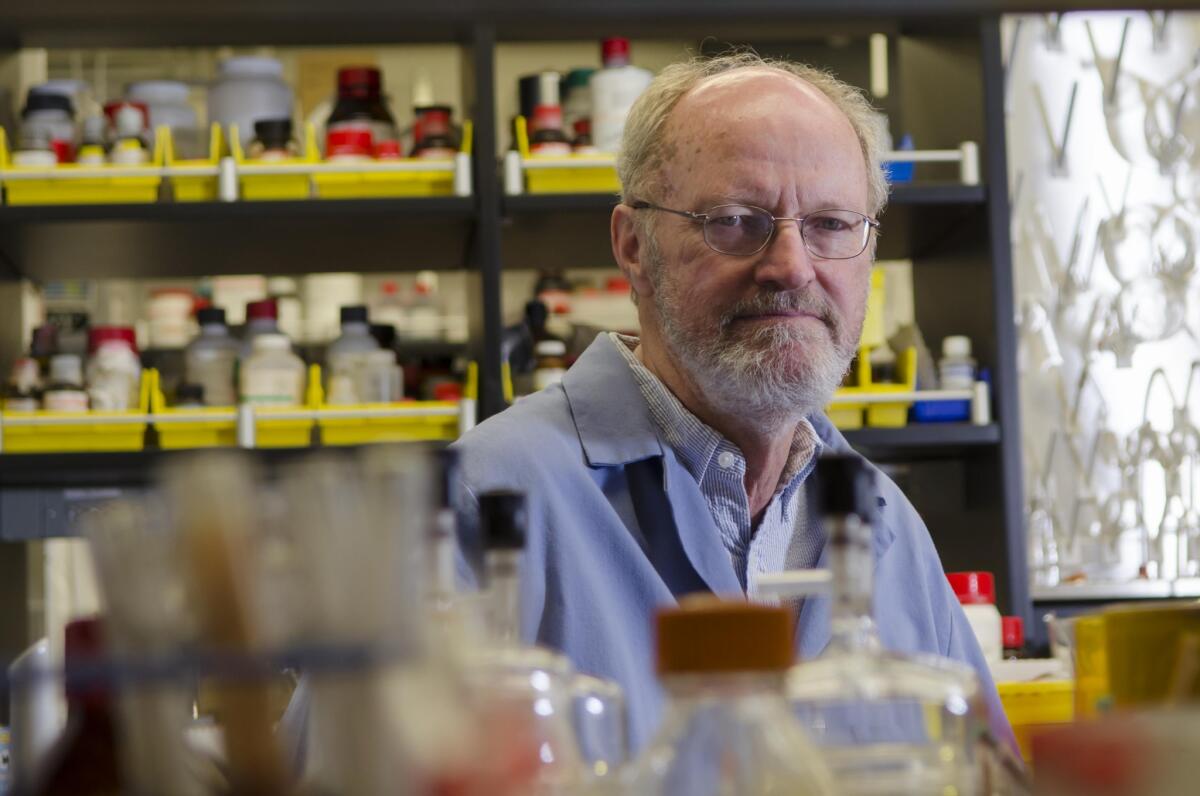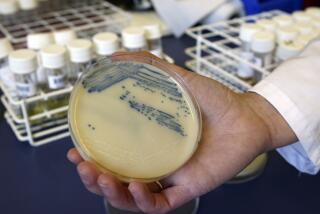Robert H. Grubbs, Caltech Nobel Prize winner who revolutionized green chemistry, dies

- Share via
Robert H. Grubbs, the Caltech Nobel Prize winner whose methods of breaking apart molecules and rebuilding them according to specification revolutionized the field of organic chemistry, has died at 79.
Exploiting a process known as metathesis, in which carbon compounds exchange parts with one another, Grubbs showed how to create a broad range of new products, from environmentally friendly plastics to resins to pharmaceuticals.
His discoveries built on the work of two other scientists, Yves Chauvin of France and Richard Schrock of MIT, with whom he shared the $1.3-million Nobel Prize in chemistry in 2005. “He was the one who took what I did and turned it into something practical,” Schrock said at the time.
A major benefit of Grubbs’ process was that it minimized wasteful and hazardous byproducts of chemical reactions, an important advance in the field of what is now called green chemistry. “Bob’s strength as a scientist was his creativity,” said Dennis Dougherty, the Norman Davidson Leadership Chair in Chemistry at Caltech. “He was the most creative chemist I ever interacted with.”
Grubbs, who was admired as much for his warmth and personal simplicity as for his achievements, died of a heart attack Dec. 19 at the City of Hope hospital in Duarte, where he was being treated for lymphoma, his son Barney said.
Robert H. Grubbs was born Feb. 27, 1942, in a farmhouse his father built near Possum Trot, Ky. The middle child between two sisters, he described his upbringing as something out of a rural American novel of manners, with a supportive extended family of aunts, uncles and grandparents, many of them farmers in tobacco country. His mother taught school for 35 years while his father worked as a mechanic for the Tennessee Valley Authority.
A lanky boy — he stood 6 feet, 6 inches in adulthood — he was interested in all things mechanical; any money earned was spent on nails instead of candy. Having spent his summers in farm work and construction, he enrolled at the University of Florida as an agricultural chemistry major. There, he landed a summer job analyzing steer feces.
A friend working in a chemistry lab saved him from a career studying animal matter, Grubbs said, by inviting him to help out at night. “I found that organic chemicals smelled much better than steer feces and that there was great joy in making new molecules,” he wrote later.
It’s not rocket science, but it’s a win for Caltech
Organic compounds based on complex arrangements of carbon atoms are the basis of all life that we know. Learning how those compounds react on a molecular level, and how to adapt them to new uses, fascinated Grubbs as a student. “Building new molecules was even more fun than building houses,” he said.
He earned his bachelor and master’s degrees at the University of Florida, then received his doctorate from Columbia University, where he met and married his wife, Helen O’Kane, who became a special education teacher. He spent a year at Stanford University as a National Institutes of Health fellow before joining the faculty of Michigan State University in 1968. A decade later, he was hired by Caltech, where he became the Victor and Elizabeth Atkins Professor of Chemistry in 1990.
When his career began, “organometallic chemistry was in its infancy and it provided a fertile field for a mechanistic chemist,” Grubbs said. He became particularly interested in metathesis, a word meaning changing places, involving chemical reactions in which two carbon-based molecules exchange fragments under the influence of a third molecule, known as a catalyst. In this way, bits of molecules can be selectively stripped out and replaced with pieces from another compound.
The natural process was first observed in the 1950s in the petrochemical industry, but scientists did not know what was going on, or even how to use it. Chauvin provided the first theoretical model in 1970, suggesting that the process is initiated by a family of chemicals called metal carbenes, in which a metal atom is double-bonded to a carbon atom. In what has been likened to a dance, the metal-carbon double-bond binds to a carbon-carbon bond in a target molecule, forming a ring of four atoms. The four then separate into new couplets, with different partners.
At the Royal Swedish Academy of Science’s news conference announcing the Nobel award in 2005, the process was demonstrated by two dancing couples. All four dancers then joined hands before separating again, with each member dancing off with a new partner.
Robert H. Grubbs shares the honor with Richard R. Schrock, a graduate of UC Riverside now at MIT, and a Frenchman.
After Chauvin’s report, Schrock began searching for a catalyst that could carry out the reaction in a predictable way, finally settling on molybdenum and tungsten. The problem was that those metals were not stable in air and were incompatible with many other compounds.
In 1992, Grubbs solved the problem by using ruthenium as a catalyst. It proved to be much more stable and could be used in a variety of substrates, including water and alcohol. One of those compounds became known as the “Grubbs catalyst” and was the standard against which all others were measured.
To Grubbs, it was a surprise the process worked. “Carbon-carbon double bonds are usually one of the strongest points in the molecule,” Grubbs told the New York Times. “To be able to rip them apart and put them back together very cleanly was a complete surprise to organic chemists.”
His work was adapted in a new family of custom-built compounds with specialized properties, such as drugs for various ailments, plastics made from vegetable oils, rather than petroleum, and herbicides.
Grubbs’ unfussy approach to his accomplishments revealed itself perhaps best in his reaction to being named a Nobelist. “I had just opened a bottle of good port,” he told the Los Angeles Times’ Tom Maugh by phone from New Zealand, “so I continued drinking it.”
In his free time, he became a climber, scaling rocks in Joshua Tree and Yosemite, and late in life adopted fly-fishing as a hobby, his son said.
Over his career, Grubbs advised and mentored more than 100 doctoral candidates and almost 200 postdoctoral associates. He also co-founded several companies, including Materia Inc. of Pasadena, which held the rights to his catalysts.
“Bob was an inspiration to Caltech colleagues and to scientists around the world, for his human qualities as much as for his pathbreaking contributions to research and society. We will keenly miss his wisdom and vision,” said Caltech President Thomas F. Rosenbaum.
Besides the Nobel Prize, Grubbs was the recipient of the Benjamin Franklin Medal from the Franklin Institute, the Arthur C. Cope Award from the American Chemical Society and the Gold Medal from the American Institute of Chemists. He was a member of the National Academy of Sciences, a fellow of the American Academy of Arts and Sciences and a member of the Honorable Order of Kentucky Colonels. He received honorary degrees from, among others, the Georgia Institute of Technology, the University of Crete in Greece, the University of Warwick in the United Kingdom, and Rheinisch-Westfälische Technische Hochschule Aachen University in Germany.
He authored more than 400 papers and held 80 patents.
Grubbs is survived by his wife; children Kathleen, Brendan and Barney; four grandchildren; and two sisters.
Johnson is a former Times staff writer. Staff writer Gregory Yee contributed to this report.
More to Read
Start your day right
Sign up for Essential California for the L.A. Times biggest news, features and recommendations in your inbox six days a week.
You may occasionally receive promotional content from the Los Angeles Times.






